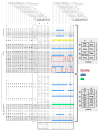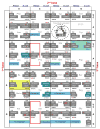Decoding in Candidatus Riesia pediculicola, close to a minimal tRNA modification set?
- PMID: 23308034
- PMCID: PMC3539174
Decoding in Candidatus Riesia pediculicola, close to a minimal tRNA modification set?
Abstract
A comparative genomic analysis of the recently sequenced human body louse unicellular endosymbiont Candidatus Riesia pediculicola with a reduced genome (582 Kb), revealed that it is the only known organism that might have lost all post-transcriptional base and ribose modifications of the tRNA body, retaining only modifications of the anticodon-stem-loop essential for mRNA decoding. Such a minimal tRNA modification set was not observed in other insect symbionts or in parasitic unicellular bacteria, such as Mycoplasma genitalium (580 Kb), that have also evolved by considerably reducing their genomes. This could be an example of a minimal tRNA modification set required for life, a question that has been at the center of the field for many years, especially for understanding the emergence and evolution of the genetic code.
Figures




Similar articles
-
Phylogenetic relationship between the endosymbiont "Candidatus Riesia pediculicola" and its human louse host.Parasit Vectors. 2022 Mar 5;15(1):73. doi: 10.1186/s13071-022-05203-z. Parasit Vectors. 2022. PMID: 35248159 Free PMC article.
-
Genome sequences of the human body louse and its primary endosymbiont provide insights into the permanent parasitic lifestyle.Proc Natl Acad Sci U S A. 2010 Jul 6;107(27):12168-73. doi: 10.1073/pnas.1003379107. Epub 2010 Jun 21. Proc Natl Acad Sci U S A. 2010. PMID: 20566863 Free PMC article.
-
Complete Genome Sequence of the Endosymbiotic Bacterium "Candidatus Riesia pediculicola".Microbiol Resour Announc. 2021 May 6;10(18):e01181-20. doi: 10.1128/MRA.01181-20. Microbiol Resour Announc. 2021. PMID: 33958407 Free PMC article.
-
Utilization of the human louse genome to study insecticide resistance and innate immune response.Pestic Biochem Physiol. 2015 May;120:125-32. doi: 10.1016/j.pestbp.2014.11.008. Epub 2014 Nov 20. Pestic Biochem Physiol. 2015. PMID: 25987230 Free PMC article. Review.
-
tRNA's wobble decoding of the genome: 40 years of modification.J Mol Biol. 2007 Feb 9;366(1):1-13. doi: 10.1016/j.jmb.2006.11.046. Epub 2006 Nov 15. J Mol Biol. 2007. PMID: 17187822 Review.
Cited by
-
Comparative genomic analysis of seven Mycoplasma hyosynoviae strains.Microbiologyopen. 2015 Apr;4(2):343-359. doi: 10.1002/mbo3.242. Epub 2015 Feb 18. Microbiologyopen. 2015. PMID: 25693846 Free PMC article.
-
Queuosine Salvage in Bartonella henselae Houston 1: A Unique Evolutionary Path.bioRxiv [Preprint]. 2024 Apr 16:2023.12.05.570228. doi: 10.1101/2023.12.05.570228. bioRxiv. 2024. Update in: Microbiology (Reading). 2024 Sep;170(9). doi: 10.1099/mic.0.001490. PMID: 38106016 Free PMC article. Updated. Preprint.
-
Functions of Bacterial tRNA Modifications: From Ubiquity to Diversity.Trends Microbiol. 2021 Jan;29(1):41-53. doi: 10.1016/j.tim.2020.06.010. Epub 2020 Jul 25. Trends Microbiol. 2021. PMID: 32718697 Free PMC article. Review.
-
Functional importance of Ψ38 and Ψ39 in distinct tRNAs, amplified for tRNAGln(UUG) by unexpected temperature sensitivity of the s2U modification in yeast.RNA. 2015 Feb;21(2):188-201. doi: 10.1261/rna.048173.114. Epub 2014 Dec 12. RNA. 2015. PMID: 25505024 Free PMC article.
-
SAXS analysis of the tRNA-modifying enzyme complex MnmE/MnmG reveals a novel interaction mode and GTP-induced oligomerization.Nucleic Acids Res. 2014 May;42(9):5978-92. doi: 10.1093/nar/gku213. Epub 2014 Mar 14. Nucleic Acids Res. 2014. PMID: 24634441 Free PMC article.
References
-
- Björk GR, Hagervall TG. Escherichia coli and Salmonella. In: Böck A, Curtis R, Kaper JB, Neidhardt FC, Nyström T, Squires CL, editors. Cellular and Molecular Biology. ASM. Press; Washington DC: 2005. http://www.ecosal.org Module 4.6.2.
-
- Cermakian N, Cedergren R. In: Modification and Editing of RNA. Grosjean H, Benne R, editors. ASM Press; Washington DC: 1998. p. 535.
Grants and funding
LinkOut - more resources
Full Text Sources
